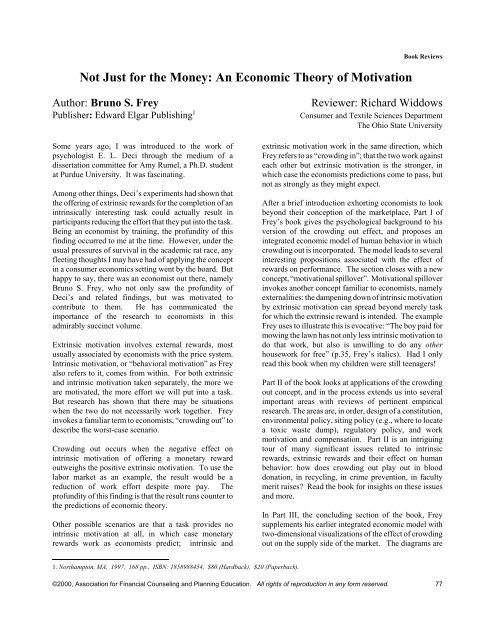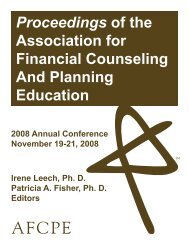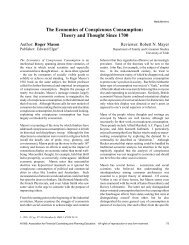Not Just for the Money: An Economic Theory of Motivation - AFCPE
Not Just for the Money: An Economic Theory of Motivation - AFCPE
Not Just for the Money: An Economic Theory of Motivation - AFCPE
You also want an ePaper? Increase the reach of your titles
YUMPU automatically turns print PDFs into web optimized ePapers that Google loves.
<strong>Not</strong> <strong>Just</strong> <strong>for</strong> <strong>the</strong> <strong>Money</strong>: <strong>An</strong> <strong>Economic</strong> <strong>Theory</strong> <strong>of</strong> <strong>Motivation</strong><br />
Book Reviews<br />
Author: Bruno S. Frey<br />
Publisher: Edward Elgar Publishing 1<br />
Some years ago, I was introduced to <strong>the</strong> work <strong>of</strong><br />
psychologist E. L. Deci through <strong>the</strong> medium <strong>of</strong> a<br />
dissertation committee <strong>for</strong> Amy Rumel, a Ph.D. student<br />
at Purdue University. It was fascinating.<br />
Among o<strong>the</strong>r things, Deci’s experiments had shown that<br />
<strong>the</strong> <strong>of</strong>fering <strong>of</strong> extrinsic rewards <strong>for</strong> <strong>the</strong> completion <strong>of</strong> an<br />
intrinsically interesting task could actually result in<br />
participants reducing <strong>the</strong> ef<strong>for</strong>t that <strong>the</strong>y put into <strong>the</strong> task.<br />
Being an economist by training, <strong>the</strong> pr<strong>of</strong>undity <strong>of</strong> this<br />
finding occurred to me at <strong>the</strong> time. However, under <strong>the</strong><br />
usual pressures <strong>of</strong> survival in <strong>the</strong> academic rat race, any<br />
fleeting thoughts I may have had <strong>of</strong> applying <strong>the</strong> concept<br />
in a consumer economics setting went by <strong>the</strong> board. But<br />
happy to say, <strong>the</strong>re was an economist out <strong>the</strong>re, namely<br />
Bruno S. Frey, who not only saw <strong>the</strong> pr<strong>of</strong>undity <strong>of</strong><br />
Deci’s and related findings, but was motivated to<br />
contribute to <strong>the</strong>m. He has communicated <strong>the</strong><br />
importance <strong>of</strong> <strong>the</strong> research to economists in this<br />
admirably succinct volume.<br />
Extrinsic motivation involves external rewards, most<br />
usually associated by economists with <strong>the</strong> price system.<br />
Intrinsic motivation, or “behavioral motivation” as Frey<br />
also refers to it, comes from within. For both extrinsic<br />
and intrinsic motivation taken separately, <strong>the</strong> more we<br />
are motivated, <strong>the</strong> more ef<strong>for</strong>t we will put into a task.<br />
But research has shown that <strong>the</strong>re may be situations<br />
when <strong>the</strong> two do not necessarily work toge<strong>the</strong>r. Frey<br />
invokes a familiar term to economists, “crowding out” to<br />
describe <strong>the</strong> worst-case scenario.<br />
Crowding out occurs when <strong>the</strong> negative effect on<br />
intrinsic motivation <strong>of</strong> <strong>of</strong>fering a monetary reward<br />
outweighs <strong>the</strong> positive extrinsic motivation. To use <strong>the</strong><br />
labor market as an example, <strong>the</strong> result would be a<br />
reduction <strong>of</strong> work ef<strong>for</strong>t despite more pay. The<br />
pr<strong>of</strong>undity <strong>of</strong> this finding is that <strong>the</strong> result runs counter to<br />
<strong>the</strong> predictions <strong>of</strong> economic <strong>the</strong>ory.<br />
O<strong>the</strong>r possible scenarios are that a task provides no<br />
intrinsic motivation at all, in which case monetary<br />
rewards work as economists predict; intrinsic and<br />
Reviewer: Richard Widdows<br />
Consumer and Textile Sciences Department<br />
The Ohio State University<br />
extrinsic motivation work in <strong>the</strong> same direction, which<br />
Frey refers to as “crowding in”; that <strong>the</strong> two work against<br />
each o<strong>the</strong>r but extrinsic motivation is <strong>the</strong> stronger, in<br />
which case <strong>the</strong> economists predictions come to pass, but<br />
not as strongly as <strong>the</strong>y might expect.<br />
After a brief introduction exhorting economists to look<br />
beyond <strong>the</strong>ir conception <strong>of</strong> <strong>the</strong> marketplace, Part I <strong>of</strong><br />
Frey’s book gives <strong>the</strong> psychological background to his<br />
version <strong>of</strong> <strong>the</strong> crowding out effect, and proposes an<br />
integrated economic model <strong>of</strong> human behavior in which<br />
crowding out is incorporated. The model leads to several<br />
interesting propositions associated with <strong>the</strong> effect <strong>of</strong><br />
rewards on per<strong>for</strong>mance. The section closes with a new<br />
concept, “motivational spillover”. <strong>Motivation</strong>al spillover<br />
invokes ano<strong>the</strong>r concept familiar to economists, namely<br />
externalities: <strong>the</strong> dampening down <strong>of</strong> intrinsic motivation<br />
by extrinsic motivation can spread beyond merely task<br />
<strong>for</strong> which <strong>the</strong> extrinsic reward is intended. The example<br />
Frey uses to illustrate this is evocative: “The boy paid <strong>for</strong><br />
mowing <strong>the</strong> lawn has not only less intrinsic motivation to<br />
do that work, but also is unwilling to do any o<strong>the</strong>r<br />
housework <strong>for</strong> free” (p.35, Frey’s italics). Had I only<br />
read this book when my children were still teenagers!<br />
Part II <strong>of</strong> <strong>the</strong> book looks at applications <strong>of</strong> <strong>the</strong> crowding<br />
out concept, and in <strong>the</strong> process extends us into several<br />
important areas with reviews <strong>of</strong> pertinent empirical<br />
research. The areas are, in order, design <strong>of</strong> a constitution,<br />
environmental policy, siting policy (e.g., where to locate<br />
a toxic waste dump), regulatory policy, and work<br />
motivation and compensation. Part II is an intriguing<br />
tour <strong>of</strong> many significant issues related to intrinsic<br />
rewards, extrinsic rewards and <strong>the</strong>ir effect on human<br />
behavior: how does crowding out play out in blood<br />
donation, in recycling, in crime prevention, in faculty<br />
merit raises? Read <strong>the</strong> book <strong>for</strong> insights on <strong>the</strong>se issues<br />
and more.<br />
In Part III, <strong>the</strong> concluding section <strong>of</strong> <strong>the</strong> book, Frey<br />
supplements his earlier integrated economic model with<br />
two-dimensional visualizations <strong>of</strong> <strong>the</strong> effect <strong>of</strong> crowding<br />
out on <strong>the</strong> supply side <strong>of</strong> <strong>the</strong> market. The diagrams are<br />
1. Northampton, MA, 1997, 168 pp., ISBN: 1858988454, $80 (Hardback), $20 (Paperback).<br />
©2000, Association <strong>for</strong> Financial Counseling and Planning Education. All rights <strong>of</strong> reproduction in any <strong>for</strong>m reserved. 77
Financial Counseling and Planning, Volume 11 (1), 2000<br />
accessible to any students who have taken an<br />
introductory course in economics, and allow Frey to<br />
move to an equally accessible discussion <strong>of</strong> <strong>the</strong><br />
consequences <strong>of</strong> crowding out <strong>for</strong> economic policy.<br />
But <strong>the</strong> final word goes to <strong>the</strong>ory. The current model that<br />
underpins applied economics as it is adopted in consumer<br />
sciences assumes that in our choice behavior we<br />
maximize satisfaction subject to resource constraints.<br />
Frey’s model claims to go beyond this narrow concept <strong>of</strong><br />
so-called rational economic man. Frey’s Homo<br />
Oeconomicus Maturus “is more mature, in <strong>the</strong> sense that<br />
he is endowed with a more refined motivational<br />
structure..” (p.118). Does this mean that rational<br />
economic man is dead?<br />
<strong>Not</strong> really. After some discussion <strong>of</strong> <strong>the</strong> possibility <strong>of</strong> a<br />
break with <strong>the</strong> neo-classical tradition through <strong>the</strong><br />
construction <strong>of</strong> a “psychological economics”, Frey claims<br />
that his book “seeks to circumvents this problem by<br />
introducing a well-defined and particular psychological<br />
effect into an existing framework <strong>of</strong> economic <strong>the</strong>ory.”<br />
(p. 123). The strategy <strong>for</strong> <strong>the</strong> integration <strong>of</strong> one root<br />
discipline into ano<strong>the</strong>r is <strong>the</strong>n described: “Introducing<br />
one psychological effect at one time accentuates <strong>the</strong><br />
difference from existing <strong>the</strong>ory. Testable propositions<br />
can be derived, and corresponding empirical analysis can<br />
be undertaken” (Frey’s italics). This is something that<br />
those in family and consumer sciences who have<br />
attempted to extend <strong>the</strong> basis <strong>of</strong> <strong>the</strong>ir econometric<br />
analysis through <strong>the</strong> inclusion <strong>of</strong> “psychological”<br />
variables have been doing <strong>for</strong> some time. As Frey says,<br />
we have probably circumvented <strong>the</strong> problem <strong>of</strong><br />
developing a new <strong>the</strong>oretical basis <strong>for</strong> our work in <strong>the</strong><br />
process. Mea culpa.<br />
78 ©2000, Association <strong>for</strong> Financial Counseling and Planning Education. All rights <strong>of</strong> reproduction in any <strong>for</strong>m reserved.





